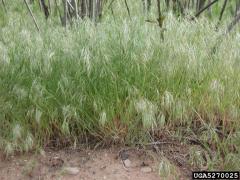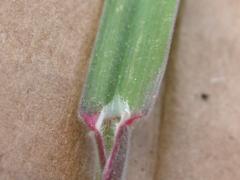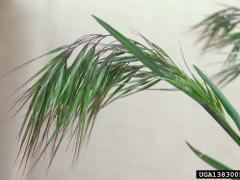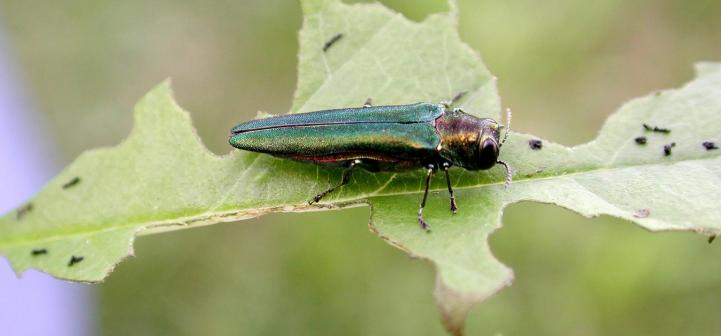Invasive Species: Bromus tectorum, Cheatgrass
Cheatgrass is an annual grass that forms tufts up to 2 ft. (0.6 m) tall. The leaves and sheaths are covered in short, soft hairs. The flowers occur as drooping, open, terminal clusters that can have a greenish, red, or purple hue. Flowering occurs in the early summer. Fruits are dry hard caryopses. Each fruit contains one seed. These annual plants will germinate in fall or spring (fall is more common), and senescence usually occurs in summer. Cheatgrass invades rangelands, pastures, prairies, and other open areas. Cheatgrass has the potential to completely alter the ecosystems it invades. It can completely replace native vegetation and change fire regimes. It occurs throughout the United States and Canada, but is most problematic in areas of the western United States with lower precipitation levels. Cheatgrass is native to Europe and parts of Africa and Asia. It was first introduced into the United States accidentally in the mid-1800s.
What are invasive species and why should we be concerned about them?
Taxonomy: Scientific and Common Names for This Species
Cyperales > Poaceae > Bromus tectorum L.
Synonym(s): downy brome, early chess, military grass, thatch bromegrass
Bromus tectorum – USDA PLANTS Profile
Distribution Maps
Cheatgrass – The reported distribution of this invasive species across the United States (Source: Invasive Plant Atlas of the United States)
Up-to-the-minute distribution maps and why they are important
Reporting This Invasive Species
What is the best way and place to report the occurrence of an invasive species?
How to report an invasive species sighting to EDDMapS – Early Detection & Distribution Mapping System
EDDMapS – Report an Invasive Species to EDDMapS.
Cooperative Extension Offices – Find your local Cooperative Extension office on this map provided by USDA.
How to Identify
This invasive species can be identified by looking for the characteristics described in the paragraphs that follow.
Grass
Cheatgrass is an annual grass that forms tufts up to 2 ft. (0.6 m) tall.
 |
 |
| Leslie J. Mehrhoff, University of Connecticut, bugwood.org | Leslie J. Mehrhoff, University of Connecticut, bugwood.org |
Foliage
The leaves and sheaths are covered in short, soft hairs.
 |
 |
| Bruce Ackley, Ohio State University, bugwood.org | Tom Heutte, USDA Forest Service, bugwood.org |
Flower
The flowers occur as drooping, open, terminal clusters that can have a greenish, red, or purple hue. Flowering occurs in the early summer.
 |
 |
| Tom Heutte, USDA Forest Service, bugwood.org | Steve Dewey, Utah State University, bugwood.org |
Fruit
Fruits are dry hard caryopses that each contain one seed.
 |
 |
| Leslie J. Mehrhoff, University of Connecticut, bugwood.org | Steve Hurst, USDA NRCS PLANTS Database, bugwood.org |
Native Species That Can Resemble Cheatgrass
– Images at invasive.org
| bugwood.org | bugwood.org |
– Images at invasive.org
| bugwood.org | bugwood.org |
Additional Images for Cheatgrass
Cheatgrass – Images at Invasive.org
Additional Information, Biology, Control and Management Resources
Control and management recommendations vary according to individual circumstances. Location, habitat, weather, and a variety of other conditions are factors that help determine the best treatment choice. To find the safest and most effective treatment for your situation, consult your state’s land-grant institution. If you will use chemicals as part of the control process, always refer to the product label.
United States Land-Grant University System – Find your land-grant university’s college of agriculture, Cooperative Extension office, or other related partner on this map provided by USDA.
Fact Sheet – Pennsylvania Dept. of Conservation and Natural Resources
Invasive Plant Atlas of New England – University of Connecticut
Element Stewardship Abstract – The Nature Conservancy
Weed of the Week – USDA Forest Service
